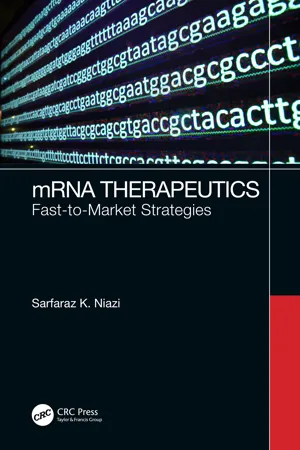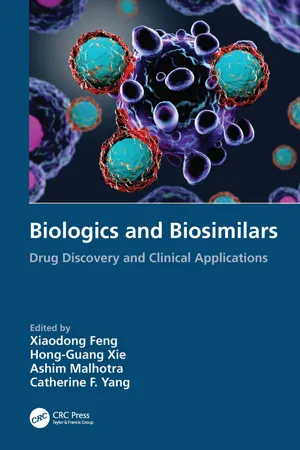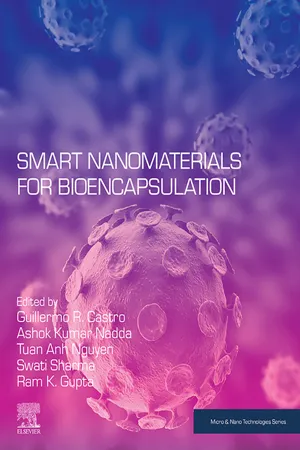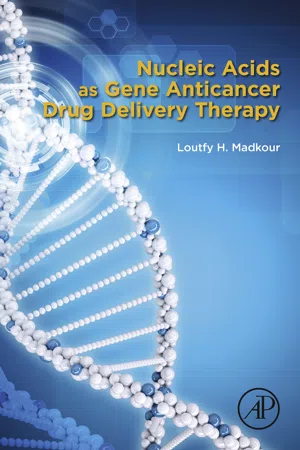Biological Sciences
mRNA Vaccine
mRNA vaccines are a type of vaccine that uses a small piece of genetic material from the virus to instruct cells in the body to produce a harmless piece of the virus, which then triggers an immune response. This approach allows for a faster and more flexible vaccine development process, as the genetic sequence of the virus can be quickly identified and used to create the vaccine.
Written by Perlego with AI-assistance
Related key terms
5 Key excerpts on "mRNA Vaccine"
- eBook - ePub
mRNA Therapeutics
Fast-to-Market Strategies
- Sarfaraz K. Niazi(Author)
- 2022(Publication Date)
- CRC Press(Publisher)
- The manufacturing process of mRNA is cell-free and independent of the mRNA sequence, making it easy and fast to develop and mass-produce a new vaccine. Therefore, mRNA Vaccines may be considered a platform technology, which makes them particularly advantageous for tackling pandemics. In contrast, to produce an inactivated or recombinant protein vaccine, it is necessary to develop specific microbial/cell culture processes with particular microbial strains or cell lines that usually require a series of long culture steps to generate the product as custom product recovery and purification steps. Moreover, cell-free manufacturing has a lower risk of microbial contamination.
- Since the antigenic protein is synthesized from the mRNA in the host cell by the host’s cell machinery, the protein generated has precisely the same structural characteristics (including posttranslational modifications) that the actual pathogen’s protein would have in the host. However, when the antigenic protein is produced industrially, for example, using bacteria or yeast cells, this is not always the case.
- In contrast to DNA vaccinations, mRNA does not require entry into the cell nucleus to be decoded, reducing the risk of DNA integration into the genome, which may exist for DNA vaccines.
mRNA does present, however, certain challenges for its use in vaccines:- Cells’ uptake of naked mRNA (i.e., mRNA that is not associated with some sort of delivery carrier such as lipid nanoparticles) is very low under normal circumstances.
- Naked mRNA is highly unstable in vivo, being rapidly degraded by ribonucleases.
- The organism perceives exogenous naked mRNA as antigenic itself and may elicit a strong immune reaction. Although this may be useful for vaccination to a certain extent, it may reduce the translation efficiency of mRNA and consequently hinder the development of an effective immune response against the antigenic protein.
4.6 Nucleoside Vaccines Perspective
It is now conceivable to develop a universal flu vaccine that will protect against every viral strain without being altered every year. Since RNA vaccines can incorporate instructions for several antigens, either strung together in a single strand or packaged together in a single nanoparticle, essentially, a single vaccine in place of multiple sexually transmitted diseases including HPV, HIV, and chlamydia can be combined. - eBook - ePub
Biologics and Biosimilars
Drug Discovery and Clinical Applications
- Xiaodong Feng, Hong-Guang Xie, Ashim Malhotra, Catherine F. Yang(Authors)
- 2022(Publication Date)
- CRC Press(Publisher)
Within the central dogma of molecular biology, DNA gets transcribed into mRNA, which then gets translated into protein [52]. The transition from DNA to mature mRNA requires different regulatory processes and splicing mechanisms. Unlike DNA vaccine strategies, mRNA Vaccines are already in a processed form, thus preventing any uncontrolled splicing by the host cell. In practice, mRNA Vaccines utilize host translational machinery to produce the target antigen, which will subsequently initiate an adaptive immune response. After inoculation, the mRNA Vaccine is internalized by resident nonimmune cells at the injection site. The mRNA is then expressed, which stimulates select PRRs of the innate immune system, such as RIG-1 and MDA5. This stimulation starts a domino effect which leads to the upregulation of signaling molecules, like cytokines and chemokines, that recruit immune cells. This process leads to the activation of cytotoxic T cells through MHC-I and helper T cells and B cells through MHC-II. Thus, mRNA Vaccines can stimulate both cell-mediated and humoral immunity [45].Currently, there are two types of mRNA Vaccines: (1) conventional, non–self-amplifying mRNA and (2) self-amplifying mRNA [45]. Conventional mRNA Vaccines only encode the antigen of interest, while self-amplifying mRNA Vaccines have auto-replicative activity based on the RNA viral vector [55 ]. Even though self-amplifying mRNA Vaccines have the potential to induce the host to produce high levels of mRNA based on the antigenic gene, the mRNA does not contain any structural components, thus it is incapable of producing infectious virions making the vaccine safe and accessible to healthy hosts [45]. mRNA Vaccines have proven successful in the plight against COVID-19 as the vaccines created by Pfizer/BioNTech, Moderna, and Takeda have been approved for emergency use in a number of countries [34]. These vaccines induce cell-mediated and humoral immunity while having intrinsic adjuvant properties reducing the need for external excipients [45]. However, mRNA is much less stable compared to DNA, and is only viable in specific storage conditions, which limits its accessibility. The Pfizer/BioNTech vaccine requires storage in a –70°C ultra-cold freezer and once thawed must be used within five days. Likewise, the Moderna vaccine requires storage within a –20°C freezer but can be used within 30 days after thawing [56 - eBook - ePub
- O. Michielin, G. Coukos(Authors)
- 2015(Publication Date)
- S. Karger(Publisher)
Moreover, in contrast to peptide vaccination in which the HLA haplotype of the patient must be prior determined, vaccination with mRNA encoding the whole antigen obviates this requirement. mRNA, through being recognized by pattern-recognition receptors, can additionally serve as a vaccine adjuvant, obviating the need for an additional adjuvant as in the case of peptide vaccinations. Such mRNA Vaccines with antigen-encoding and immunostimulatory properties can be easily produced via in vitro transcription in a cost-effective manner and tailored in order to exploit its potential for research and clinical use [ 34 ]. In 1995, naked mRNA was first used for the induction of antigen-specific immune responses in mice upon intramuscular injection of mRNA encoding for carcinoembryonic antigen [ 35 ]. Similarly, intradermal injection of naked β-galactosidase mRNA to the ear pinna of mice resulted in the induction of cytotoxic T cells as well as antibody responses against the encoded protein [ 36 ]. The combination of GM-CSF treatment with naked mRNA vaccination in a similar setting enhanced the humoral response and further polarized it to cellular immune responses [ 37 ]. Intradermal delivery of mRNA upon its complexation with protamine is also followed in various studies to protect RNA from RNase-mediated degradation. Initial studies involved the direct administration of protamine-complexed RNA and were able to induce tumor regression and long-term antitumor immunity [ 38 ]. A newer generation of such vaccines was comprised of two components, free and protamine-complexed mRNA, to balance the protein expression and immunostimulation, respectively [ 39 ]. These vaccines protected mice from tumor challenge and elicited therapeutic effects in preclinical mouse models of cancer - eBook - ePub
- Guillermo R. Castro, Ashok Kumar Nadda, Swati Sharma, Ram K. Gupta, Tuan Anh Nguyen(Authors)
- 2022(Publication Date)
- Elsevier(Publisher)
Vaccines are considered one of the most important milestones in medicine. In an era of unmet scientific advance in vaccine technologies, the development of new vaccines faces challenges including their high cost of development and the slow time lines for vaccine advancement to clinical testing (i.e.an effective and safe vaccine typically takes over a decade to be created and validated), among other complexities. The increased occurrence of emerging and reemerging infections could benefit greatly from rapid vaccine interventions. In this sense, the current COVID-19 pandemic is an unprecedented example of this necessity due to the global impact and spread of the SARS-CoV-2 worldwide. For the first time, vaccines were rolled out in less than a year after the initial outbreak of the disease in Wuhan, China, in 2019.Among the few technologies in research in the last three decades, a new class of vaccines based on RNA technology came to light and showed its efficacy in mitigating the severe forms of the disease. mRNA Vaccines as well as DNA vaccines represent a promising alternative to manufacturing conventional vaccines due to their flexibility and rapid production speed.Nucleic acid-based vaccines compared to conventional vaccines such as killed or attenuated microorganisms, toxoids, polysaccharide conjugates, or protein-based subunits; have the potential to overcome this challenge owing to its reproducibility in manufacturing, stability under transport conditions, safety profile, and cost efficiency. These third-generation vaccines or genetic vaccines are based on the introduction of foreign DNA or RNA into host cells. The codified antigens, together with an adjuvant and an appropriate delivery system, are responsible for exerting an adequate immune response that protects against pathogen natural infection. More importantly, their use is not limited to the prophylaxis of infection diseases, but can also be applied in gene therapy, immunotherapy, autoimmunity, allergy, and cancer diseases. In fact, mRNA Vaccines were first proposed and researched as therapeutic vaccines to fight cancer and other noninfectious diseases as early as 1989. - Loutfy H. Madkour(Author)
- 2019(Publication Date)
- Academic Press(Publisher)
20 ]. Nanoparticles have been extensively studied in the field of drug delivery in light of their ability to efficiently deliver drugs to target sites, protect drugs from endogenous enzymes, and remain in the circulation for long periods of time.Cancer immunotherapy is quickly growing to be the fourth most important cancer therapy, after surgery, radiation therapy, and chemotherapy. Immunotherapy is the most promising cancer management strategy because it orchestrates the body’s own immune system to target and eradicate cancer cells, which may result in durable antitumor responses and reduce metastasis and recurrence more than traditional treatments.RNA vaccines traditionally consist of messenger RNA (mRNA) synthesized by in vitro transcription using a bacteriophage RNA polymerase and template DNA that encodes the antigen(s) of interest. Once administered and internalized by host cells the mRNA transcripts are translated directly in the cytoplasm and then the resulting antigens are presented to antigen-presenting cells (APCs) to stimulate an immune response. Alternatively, dendritic cells (DCs) can be loaded with either tumor-associated antigen (TAA) mRNA or total tumor RNA and delivered to the host to elicit a specific immune response. Nanomaterials hold great promise in further improving the efficiency of cancer immunotherapy—in many cases, they are even necessary for effective delivery.mRNAs are another kind of nontoxic molecule for nucleic acid-based vaccination therapies. The physiological role of mRNA is to transfer genetic information from the nucleus to the cytoplasm, and then to be translated into its corresponding protein. The safety of mRNA-based treatments supports the use of mRNA vaccination for therapeutic or prophylactic approaches. Due to the ease of degradation of RNA by extracellular ribonucleases the success of RNA vaccines highly depends on a proper delivery system. Based on an established method for liposome-nucleic acid complex (lipoplex, LPX) preparation [21] , an mRNA lipoplex was constructed by mixing the reporter firefly luciferase (Luc)-encoding mRNA and cationic liposomes composed of common lipids such as N-(1-(2,3-dioleyloxy)propyl)-N,N,N-trimethylammonium chloride (DOTMA) and dioleoyl phosphatidylethanolamine (DOPE). By gradually decreasing the positive-to-negative charge ratio, IV-injected Luc-LPX resulted in a luciferase expression shift from the lungs to the spleen, and even an exclusively splenic signal for near-neutral and slightly negative particles. The LPX can protect RNA from degradation by extracellular ribonucleases and can mediate its efficient uptake, as well as facilitating expression of the encoded antigen by DC populations and macrophages in various lymphoid compartments [22]
Index pages curate the most relevant extracts from our library of academic textbooks. They’ve been created using an in-house natural language model (NLM), each adding context and meaning to key research topics.




